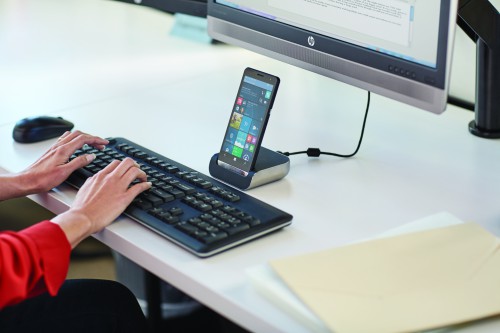
This might be hard for younger readers to believe, but it wasn’t that long ago that you could walk into an office and find just one or two devices on a person’s desk. Most likely, you’d have seen such relics as a landline phone and a desktop computer, maybe even a fax machine.
Today, you’d probably see a laptop, a tablet, a smartphone – or two – and maybe a smart watch, point-of-sale device and who knows what else. Odds are that some of the devices belong to the company, some to the worker, and the personal gadgets are used for tasks both in and out of the office.
 I’ve asked Michael Park, Vice President and General Manager of Mobility at HP Inc to share his insights with us.
I’ve asked Michael Park, Vice President and General Manager of Mobility at HP Inc to share his insights with us.
The proliferation of all these devices has gotten a little ridiculous. Instead of having a phone and PC that you can use for everything, we find ourselves in a world where we need different devices to do different tasks depending our location, the type of work and personal preference. We might start a project on our laptop in the office, switch to a tablet on the bus home and then finish it on the smartphone from the couch before bed. Mobility has been great for productivity; employees are 34 percent more productive when they can use mobile devices to get work done. It’s also nice to have choices, but who wants to haul four or five different gadgets around with them all the time? I don’t know about you, but I don’t have that many pockets.
The good news is the tide is turning toward fewer devices. As mobile devices get more powerful, batteries last longer and networks get stronger, we’ll be able to do virtually everything from our smartphones. As younger generations enter the workforce, they’ll expect to use technology for work the same way they have used it in their personal lives. By 2030, more than 65 percent of the workforce will have been born after 1980. They will have been raised with the Internet and mobile phones, and if you walk them to their old-fashioned desktop workstation, they will turn around and walk out the door. According to the Mobile Work Exchange, 88 percent of HR managers reported they have had an employee quit because of lack of telework opportunities.
The other trend helping move us toward a one-device world is that software productivity companies are starting to put mobile first. Many workers rely on products from the likes of Microsoft and Salesforce to get their work done on a daily basis. Those companies are advancing how we work, and they are making the mobile experience for their software and platforms better and better. Hardware manufacturers are working more closely with the software companies to integrate the productivity tools into their smartphones and tablets to create a seamless experience that rivals what we’re used to doing on larger screens.
Small businesses in particular have a big opportunity to capitalize on these trends and replace multiple devices with a single device that can do everything the worker needs it to. For many small businesses, smartphones will enable consolidation of paper, desktops, laptops, tablets and POS devices.
Despite these trends and the benefits that come with them, many companies struggle to implement mobile-first strategies. It can be especially difficult for small businesses because they often don’t have a dedicated IT team and their technology budgets tend to be tight. They also tend to be slower to adopt new technology if what they’ve been using is considered good enough.
So how can small businesses help themselves consolidate devices? While the younger workforce demands mobility, companies need to take some steps to be prepared and protected.
- Train your employees.Require password protection. Better yet, encourage or pay for devices and services that feature biometric security or dual authentication. Teach your employees not to fall for phishing scams or to download potentially dangerous apps and files.
- Limit data access. Create policies around who can access company data from which devices. Only allow certain employees to access certain data or only provide a select group of employees access to particularly sensitive information. You might even consider a mobile data management solution that would allow you to geo-fence data access based on location, and of course you should have the basics in place for wiping data from an employee’s device if they leave the company.
- Use or build apps. In addition to the general productivity applications I mentioned above, there are countless mobile applications specifically aimed at retail, manufacturing, accounting, food service, farming, construction and just about every other industry. There also are several platforms for building your own apps, and their use is growing. Seven percent of companies have built mobile apps to facilitate workflow for their employees.
- Embrace cloud and virtualization. Cloud-based services offer advantages for small businesses looking to go mobile. They can be deployed quickly, scaled up and down depending on need, and support a variety of devices and applications, as well as provide data protection and recovery. Meanwhile, technology providers are finding new ways to virtualize previously desktop-only applications for use on mobile devices, which will be imperative to drive workforce mobility in the future.
Once in a while I step back and laugh at the fact that just a few years ago, people worked with just a computer and a phone. We started small, saw the number of devices explode, and now we’re heading back to just a couple. Apparently, history does repeat itself.
